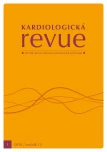Treatment options in the management of vascular stiffness
Authors:
J. Filipovský
Authors‘ workplace:
II. interní klinika LF a FN Plzeň
Published in:
Kardiol Rev Int Med 2010, 12(1): 7-9
Overview
Increased stiffness of central vasculature occurs as a consequence of mechanical attrition of the vascular wall. Age and pressure load are among the most important contributing factors. High arterial stiffness is now perceived, similar to left ventricular hypertrophy, as one of the organ complications of hypertension. Pulse wave velocity represents the gold standard in the non‑invasive measurement of arterial stiffness; central systolic blood pressure estimation is another important parameter. Intervention studies showed that, of the available agents, renin‑angiotensin system inhibitors produced the most significant effect on arterial stiffness, particularly in combination with dihydropyridine‑type calcium channel blockers. Nevertheless, these agents exert their effect with a delay and thus it is imperative to search for new compounds that would be able to affect arterial stiffness more efficiently. Aortal rigidity is among the potential future therapeutic targets, principally in hypertensive patients in primary prevention.
Key words:
arterial stiffness – pulse wave velocity – central blood pressure – renin‑angiotensin system – aldosterone
Sources
1. Laurent S, Cockcroft J, Van Bortel L et al. Abridged version of the expert consensus document on arterial stiffness. Artery Res 2007; 1: 2–12.
2. Filipovský J. Tepenný systém při hypertenzi. In: Widimský J a kol (eds). Hypertenze. 2. vyd. Praha: Grada Publishing 2004: 137–154.
3. Filipovský J. Centrální a periferní krevní tlak a jejich ovlivnění léčbou. Kardiol Rev 2008; 10: 147–151.
4. Mancia G, De Backer G, Dominiczak A et al. The task force for the management of arterial hypertension of the European Society of Hypertension, The task force for the management of arterial hypertension of the European Society of Cardiology. 2007 Guidelines for the management of arterial hypertension: The Task Force for the Management of Arterial Hypertension of the European Society of Hypertension (ESH) and of the European Society of Cardiology (ESC). Eur Heart J 2007; 28: 1462–1536.
5. Guérin AP, Blacher J, Pannier B et al. Impact of Aortic Stiffness Attenuation on Survival of Patiens in End‑Stage Renal failure. Circulation 2001; 103: 987–992.
6. Morgan T, Lauri J, Bertram D et al. Effect of different antihypertensive drug classes on central aortic pressure. Am J Hypertens 2004; 17: 118–123.
7. Asmar R, Topouchian J, Pannier B et al. Pulse wave velocity as endpoint in large‑ scale intervention trial. The Complior study. J Hypertension 2001; 19: 813–818.
8. Williams B, Lacy PS, Thom SM et al. CAFE Investigators; Anglo‑ Scandinavian Cardiac Outcomes Trial Investigators; CAFE Steering Committee and Writing Committee. Differential impact of blood pressure‑lowering drugs on central aortic pressure and clinical outcomes: principal results of the Conduit Artery Function Evaluation (CAFE) Study. Circulation 2006; 113: 1213–1225.
9. Matsui Y, Eguchi K, O’Rourke MF et al. Differential effects between a calcium channel blocker and a diuretic when used in combination with angiotensin II receptor blocker on central aortic pressure in hypertensive patients. Hypertension 2009; 54: 716–723.
Labels
Paediatric cardiology Internal medicine Cardiac surgery CardiologyArticle was published in
Cardiology Review

2010 Issue 1
Most read in this issue
- Carvedilol as a treatment option for cardiovascular diseases
- Depression in patients with cardiovascular disease
- Tenecteplase in current clinical practice
- New players on the antiplatelet therapy chequerboard – what can we expect?
